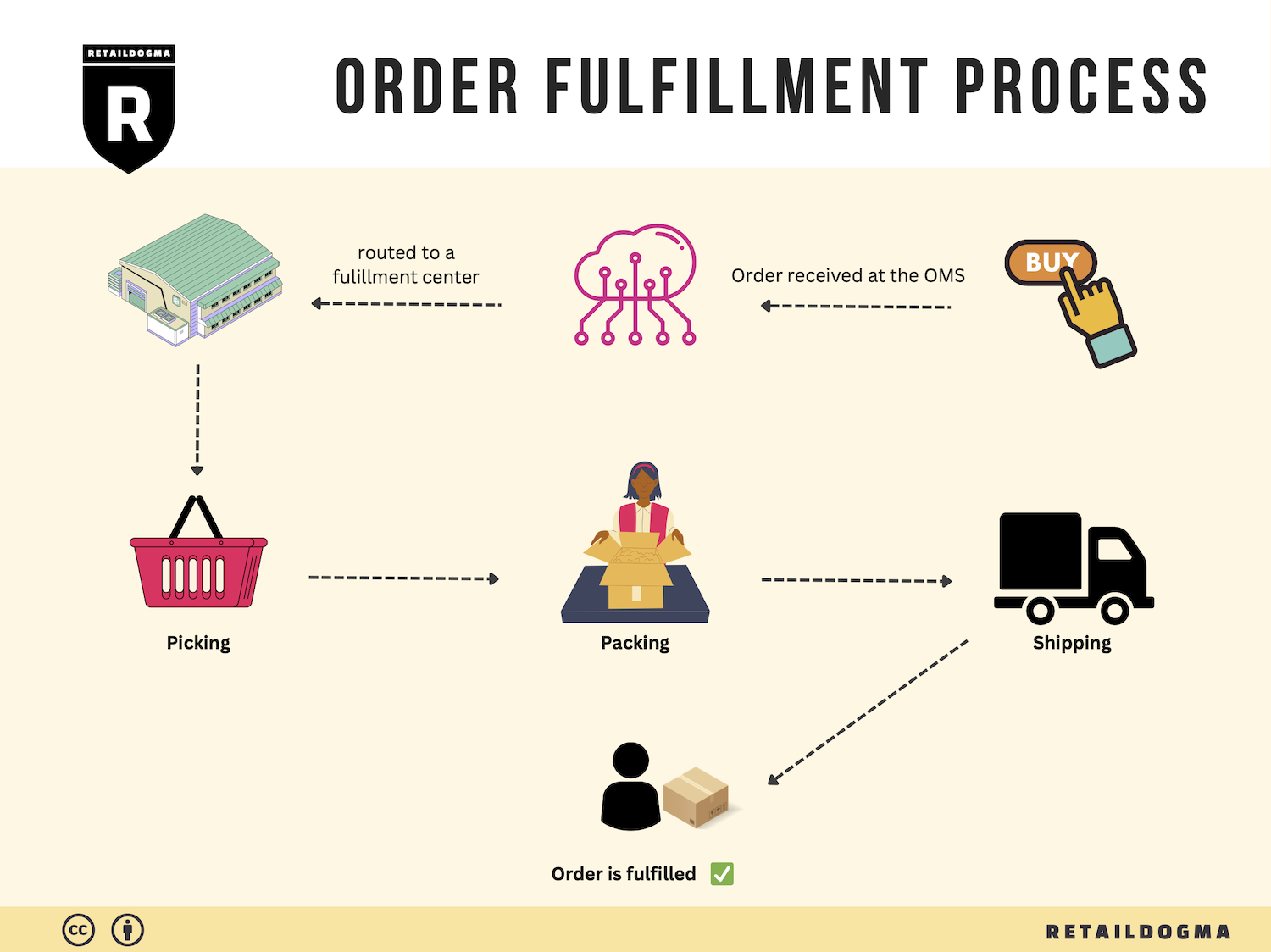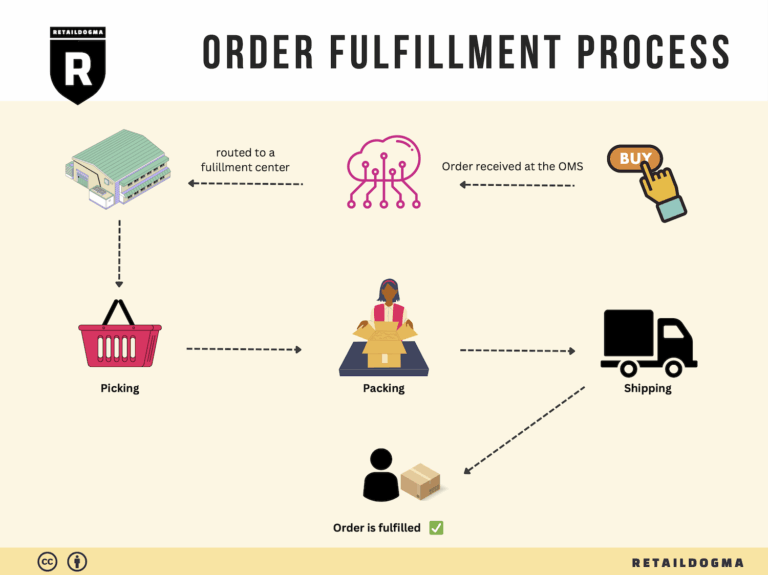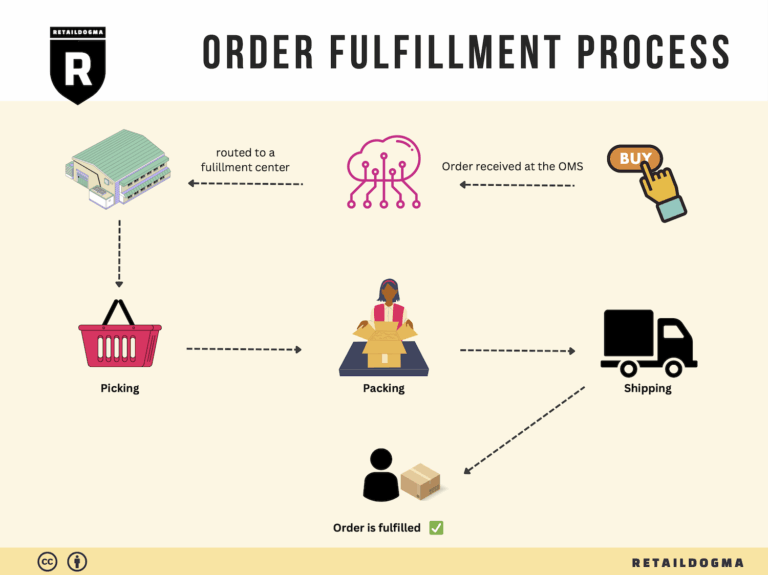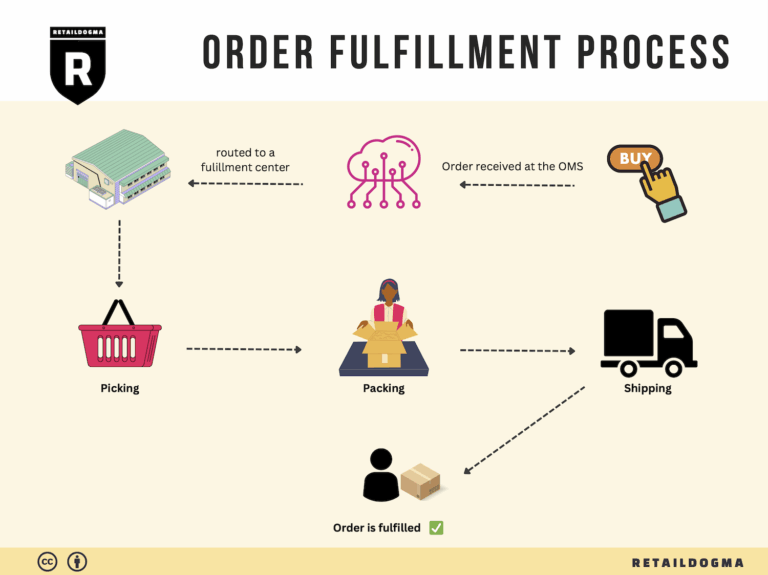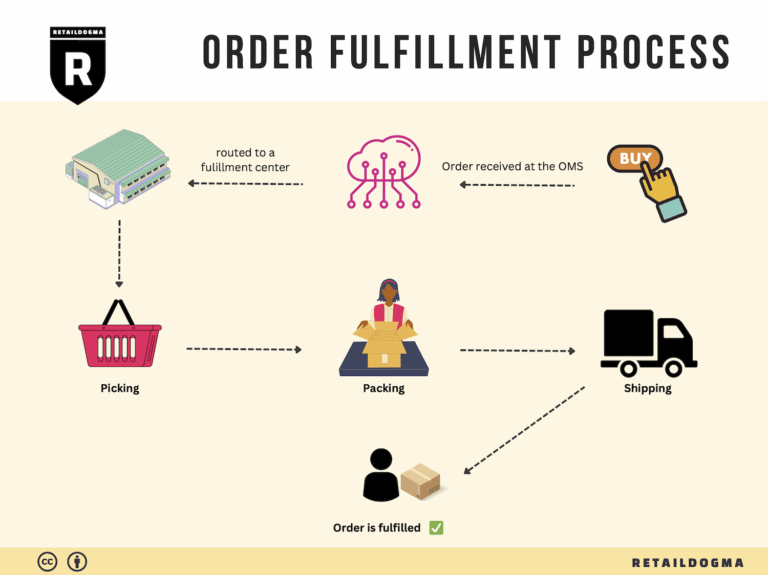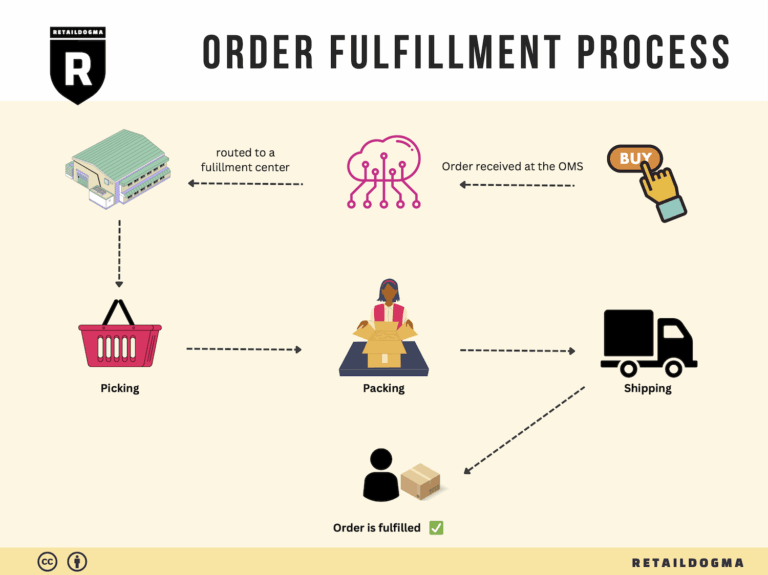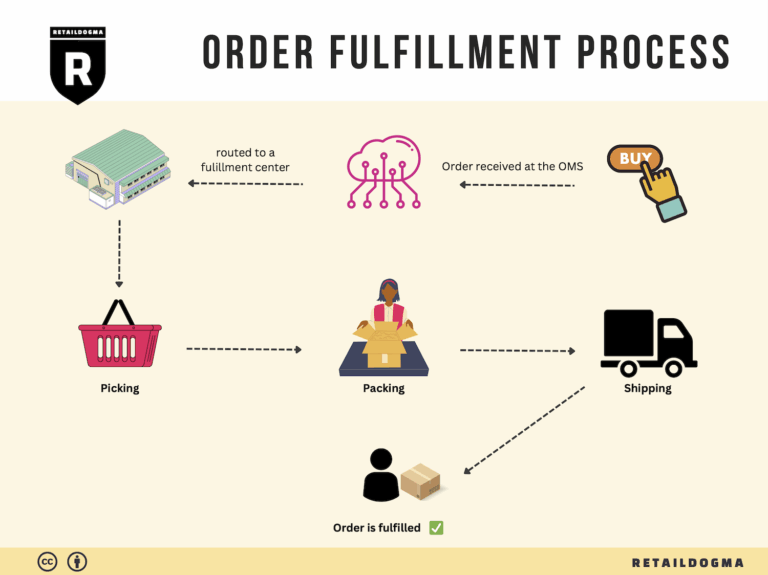Ecommerce Fulfillment Services: The Ultimate Guide (2025)
What is E-commerce Fulfillment? An Introduction for Growing Businesses
Understanding E-commerce Fulfillment
As your online business begins to grow, one of the most common pain points you may encounter is the overwhelming task of packing and shipping orders. The excitement of increased sales can quickly turn into stress as you juggle inventory management, order processing, and delivery logistics. This is where e-commerce fulfillment comes into play—a crucial component of your business that encompasses all the steps necessary to get a product from your warehouse to your customer’s doorstep.
Simply put, fulfillment is the process of receiving, processing, and delivering customer orders. It involves everything from sourcing your products to managing inventory, picking and packing orders, and handling shipping. A streamlined fulfillment process not only enhances customer satisfaction by ensuring timely deliveries but also helps you maintain control over your operational costs.
This guide aims to demystify e-commerce fulfillment for growing businesses like yours. We’ll explore the various fulfillment models available, including third-party logistics (3PL) and Fulfillment by Amazon (FBA), allowing you to determine which option aligns best with your business goals. You’ll also learn about core fulfillment services, such as warehousing, order processing, and returns management, which are essential for a smooth operation.
Choosing the right fulfillment partner can significantly impact your business’s success. We’ll provide you with practical tips on what to look for in a partner, ensuring that you select one that meets your specific needs and maintains the quality of service your customers expect. Additionally, we’ll discuss pricing structures and how to evaluate costs associated with different fulfillment options, helping you to budget effectively and avoid unexpected expenses.
Ultimately, the goal of this guide is to empower you to make informed decisions about your logistics strategy. By understanding the nuances of e-commerce fulfillment, you can build a robust framework that supports your growth ambitions, enhances customer experience, and ultimately drives profitability. So, whether you’re just starting out or looking to refine your existing fulfillment processes, this guide will equip you with the knowledge you need to succeed in the fast-paced world of online retail.
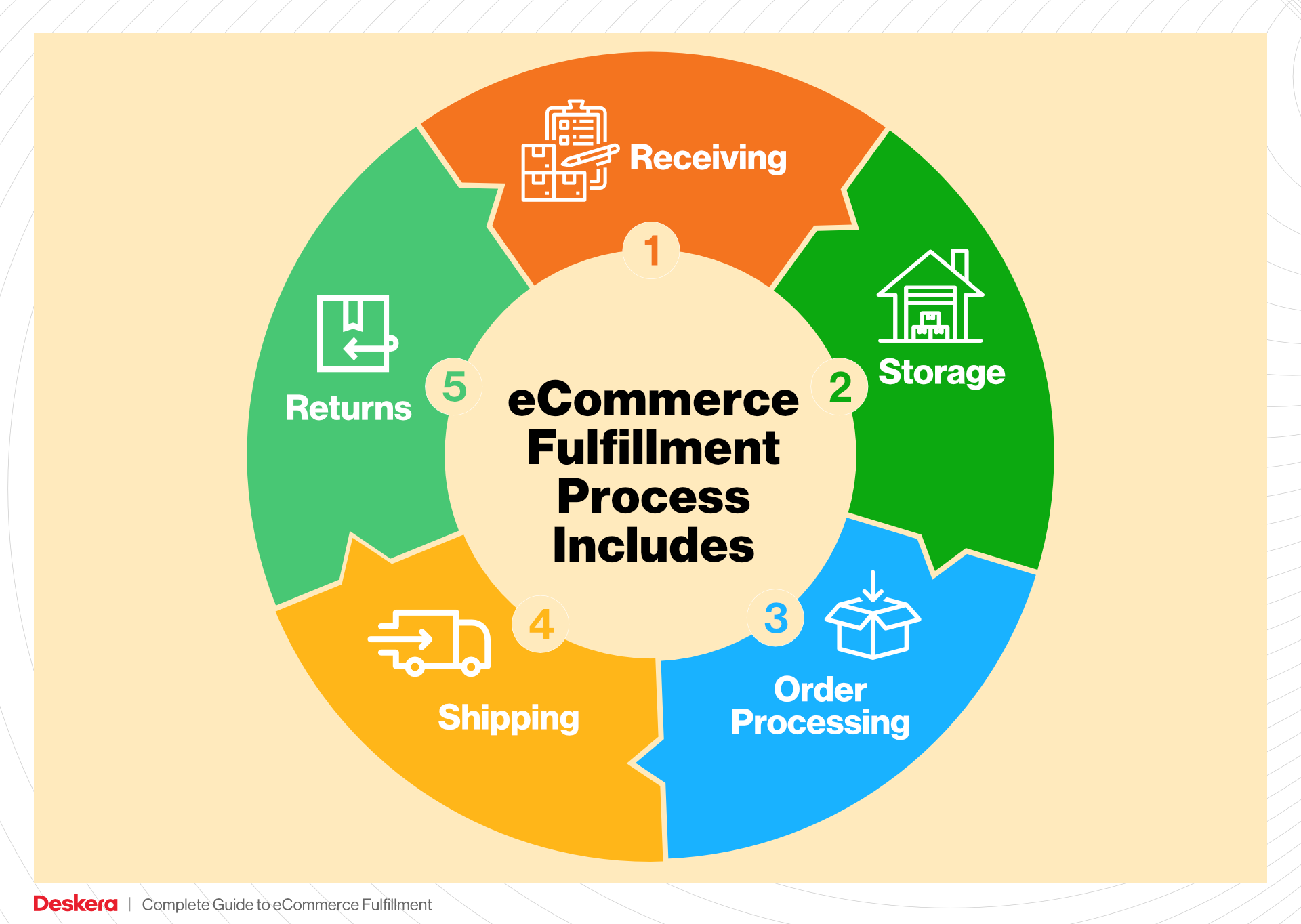
What You’ll Learn In This Guide
- What is E-commerce Fulfillment? An Introduction for Growing Businesses
- The Order Fulfillment Process: From ‘Buy’ Button to Customer’s Door
- Comparing Fulfillment Models: In-House vs. 3PL vs. Dropshipping
- A Deep Dive into Amazon FBA: Pros, Cons, and Who It’s For
- Core Services Offered by Fulfillment Centers
- How to Choose a Fulfillment Partner: A 6-Point Checklist
- Understanding Fulfillment Pricing: A Breakdown of Common Fees
- Frequently Asked Questions (FAQs) about Fulfillment
- Conclusion: Is Outsourcing Fulfillment the Right Move for Your Business?
- Important Disclaimer
The Order Fulfillment Process: From ‘Buy’ Button to Customer’s Door
1. Receiving Inventory
The order fulfillment process begins with receiving inventory from suppliers or manufacturers. This step involves checking the incoming shipments against purchase orders to ensure that the correct quantities and items have been delivered. Each product should be tagged with a Stock Keeping Unit (SKU), which serves as a unique identifier for tracking inventory levels and sales.
Importance: Proper inventory receiving is crucial for maintaining accurate stock levels and preventing discrepancies that could lead to order fulfillment errors. This step sets the foundation for the entire fulfillment process, as any mistakes here can cascade down the line, resulting in delays and customer dissatisfaction.
Key Term: SKU – A Stock Keeping Unit is a unique identifier for each distinct product and service that can be purchased. It helps in tracking inventory efficiently.
2. Warehouse Storage
Once inventory is received, the next step is warehouse storage. This involves organizing the products in a way that maximizes space and ensures easy retrieval. Effective storage solutions can include shelving, bins, or pallets, depending on the size and type of products. Implementing a logical layout and utilizing inventory management systems can significantly enhance efficiency.
Importance: Efficient warehouse storage minimizes the time spent searching for products and reduces the risk of errors during the picking process. It allows for better inventory management and helps in maintaining optimal stock levels, ultimately leading to faster order fulfillment and improved customer satisfaction.
Key Term: Inventory Management System – A software solution that helps businesses manage their inventory levels, orders, sales, and deliveries. It provides real-time data that aids in decision-making and operational efficiency.

3. Order Picking
The third step is order picking, where warehouse staff retrieve the products that have been ordered by customers. This process typically starts when an order is placed, triggering a pick list that outlines the items and their locations within the warehouse. Efficient picking methods, such as batch picking or wave picking, can be employed to streamline this step.
Importance: Accurate and efficient order picking is vital to ensure that customers receive the correct items in a timely manner. Errors during picking can lead to returns, customer complaints, and loss of trust. Optimizing this step not only enhances operational efficiency but also contributes to customer retention.
Key Term: Pick List – A document or digital tool that outlines the items to be picked for fulfilling customer orders. It includes product details and their locations, guiding staff through the warehouse.
4. Order Packing
After items are picked, the next step is order packing, which involves securely packaging the products for shipment. This includes selecting appropriate packing materials, ensuring that items are protected from damage during transit, and labeling packages with shipping details. Packing slip generation, which includes order details, is also part of this process.
Importance: Proper packing is essential to prevent damage during shipping and to provide customers with a positive unboxing experience. It also minimizes the likelihood of returns due to damaged products, thus safeguarding your bottom line. Attention to detail in this stage reinforces brand trust and customer satisfaction.

Key Term: Packing Slip – A document that accompanies the shipment, detailing the items included in the package. It provides transparency and helps customers verify their orders upon receipt.
5. Shipping & Delivery
The final step in the order fulfillment process is shipping and delivery. Once orders are packed, they are handed over to carriers for delivery to customers. This step includes selecting the right shipping method, generating tracking information, and communicating shipping details to customers. Balancing speed and cost-effectiveness is crucial during this phase.
Importance: Timely shipping and reliable delivery are critical factors in customer satisfaction. Customers expect their orders to arrive quickly and in good condition. A well-managed shipping process enhances the overall customer experience and encourages repeat business.
Key Term: Tracking Information – A unique identifier provided by shipping carriers that allows customers to monitor the progress of their shipment. It enhances transparency and keeps customers informed about their order status.
By understanding and optimizing these five steps of the order fulfillment process, e-commerce businesses can improve operational efficiency, enhance customer satisfaction, and ultimately drive growth. Each step plays a vital role in ensuring that products move smoothly from the moment they are ordered until they reach the customer’s door.
Comparing Fulfillment Models: In-House vs. 3PL vs. Dropshipping
Fulfillment Model Comparison
| Model | Who Handles Inventory | Best For (Business Stage) | Key Advantage | Key Disadvantage |
|---|---|---|---|---|
| In-House Fulfillment | Business itself | Established businesses with stable order volume | Complete control over inventory and customer experience | High initial investment and resource-intensive |
| Third-Party Logistics (3PL) | Third-party logistics provider | Growing businesses needing scalability | Access to expertise and technology without heavy investment | Less control over fulfillment process |
| Dropshipping | Supplier/manufacturer | Startups and small businesses with limited capital | Low overhead and no need to manage inventory | Lower profit margins and reliance on supplier reliability |
In-House Fulfillment
In-house fulfillment entails managing the entire logistics process within your own facilities. This model is particularly suited for established businesses that have a steady order volume and require a high level of control over their inventory and fulfillment processes. By handling everything from warehousing to shipping, businesses can ensure that their branding and customer experience are consistent and tailored to their standards. The key advantage of in-house fulfillment is the total control it provides over the entire supply chain, allowing for direct oversight of inventory management and the ability to customize packaging and shipping. However, this model also comes with significant disadvantages, including the necessity for a substantial initial investment in infrastructure and staffing. Additionally, it can be resource-intensive, diverting focus from core business activities such as marketing and product development. Scaling operations can also be challenging and costly, making this model best suited for larger enterprises or businesses with high margins that can absorb the associated costs.
Third-Party Logistics (3PL)
Third-party logistics (3PL) providers specialize in handling various aspects of the logistics process, including inventory storage, order fulfillment, and shipping. This model is ideal for growing businesses that are experiencing an increase in order volume and need a scalable solution. By outsourcing fulfillment to a 3PL, businesses can focus more on product sourcing and marketing while leveraging the expertise and technology of the logistics provider. The key advantage of utilizing a 3PL is that it reduces the need for significant capital investment in warehousing and logistics technology. Additionally, 3PLs often have established processes that can lead to fewer mistakes and a more efficient fulfillment operation. However, businesses that choose this model must also consider the trade-offs. They may have less control over the handling and shipping processes, which can impact customer satisfaction. Moreover, if a 3PL’s service quality does not align with a business’s standards, it can lead to service issues that negatively affect the customer experience. This model is best suited for businesses looking to scale quickly without the burden of managing logistics in-house.
Dropshipping
Dropshipping is a fulfillment model where the retailer does not hold inventory but instead relies on suppliers or manufacturers to ship products directly to customers. This approach is particularly advantageous for startups and small businesses with limited capital, as it requires minimal upfront investment in inventory and warehousing. The key advantage of dropshipping is the low overhead; businesses can offer a wide range of products without the financial risk of holding stock. This model allows entrepreneurs to focus on marketing and sales without the logistical complexities of inventory management. However, dropshipping also has notable disadvantages, including lower profit margins due to the reliance on suppliers for fulfillment. Additionally, businesses are dependent on the reliability of their suppliers, which can lead to issues such as stockouts or delays in shipping that ultimately affect customer satisfaction. For businesses that prioritize flexibility and low initial costs, dropshipping can be an attractive option, but it requires careful management of supplier relationships to ensure a positive customer experience.
In conclusion, selecting the right fulfillment model is crucial for e-commerce businesses aiming to scale effectively. Each model has distinct advantages and disadvantages, and the best choice will depend on the specific needs, resources, and growth stage of the business. By understanding the nuances of in-house fulfillment, 3PL, and dropshipping, e-commerce operators can make informed decisions that align with their operational goals and customer expectations.
A Deep Dive into Amazon FBA: Pros, Cons, and Who It’s For
Understanding Fulfillment by Amazon (FBA)
Fulfillment by Amazon (FBA) is a service that allows e-commerce sellers to store their products in Amazon’s fulfillment centers. Amazon takes care of storage, packaging, shipping, and customer service on behalf of the sellers. This model enables businesses of all sizes to leverage Amazon’s vast logistics network and customer base, significantly enhancing their operational capabilities.
How FBA Works
-
Product Listing and Shipment: Sellers first create product listings on Amazon and ship their inventory to Amazon’s warehouses. Each product is labeled with a unique identifier (usually an Amazon Standard Identification Number, or ASIN).
-
Storage: Once the products arrive at the fulfillment center, they are stored until an order is placed. Amazon manages the inventory, ensuring that products are well-organized and readily accessible.
-
Order Processing: When a customer places an order for a product fulfilled by FBA, Amazon handles the picking, packing, and shipping. Orders are processed quickly, often allowing for same-day or next-day delivery.
-
Customer Service and Returns: Amazon also manages customer service inquiries and returns for FBA products. This includes dealing with customer questions, processing returns, and issuing refunds.
-
Fees: Sellers are charged fees for using FBA, which include storage fees based on the volume of inventory stored and fulfillment fees per item sold.
Pros of Using Amazon FBA
1. Prime Eligibility
One of the most significant advantages of FBA is that products become eligible for Amazon Prime. This status gives sellers access to millions of Prime members who expect fast, free shipping. Prime eligibility can lead to increased visibility and higher sales, as many customers filter their searches to show only Prime-eligible items.
2. Customer Trust
Amazon is a well-established and trusted brand. By using FBA, sellers can leverage this trust, as customers often feel more secure purchasing products fulfilled by Amazon. The reliable shipping and customer service associated with FBA also enhance buyer confidence, which can lead to higher conversion rates.
3. Multi-Channel Fulfillment
FBA isn’t limited to sales on Amazon alone. Sellers can also use FBA to fulfill orders from other sales channels, such as their own e-commerce websites or platforms like eBay. This multi-channel fulfillment capability allows businesses to streamline their logistics while still reaching a broader audience.
4. Scalability
As businesses grow, FBA provides the scalability needed to handle increased order volumes without the need for additional infrastructure or personnel. Sellers can focus on sourcing and marketing their products while Amazon manages the logistics.
5. Time Savings
Outsourcing fulfillment to Amazon saves sellers considerable time. Instead of handling packing, shipping, and customer service, sellers can devote their efforts to product development and marketing strategies that drive sales.
Cons of Using Amazon FBA
1. High Fees
While FBA offers many conveniences, it comes with a price. Sellers must pay for storage space and fulfillment services, which can add up quickly, especially for those with lower sales volumes. Fees are charged per item and can vary based on the time of year, making it essential for sellers to calculate their costs carefully.
2. Strict Inventory Rules
Amazon has specific guidelines regarding inventory management, including storage limits and performance metrics. Sellers must maintain healthy inventory levels to avoid long-term storage fees and potential penalties for poor sales performance. This can be challenging for new sellers or those with fluctuating demand.
3. Commingling Risks
When using FBA, sellers’ products may be commingled with those of other sellers. This means that if a customer receives a damaged or defective item from another seller, it can negatively impact the original seller’s reputation. Sellers have limited control over the quality of products shipped under their brand, which poses a risk to their brand integrity.
4. Loss of Control
Outsourcing fulfillment means that sellers relinquish some control over their inventory management, packing, and shipping processes. This can lead to inconsistencies in branding and customer experience, as Amazon handles packaging and shipping on behalf of the seller.
5. Return Policies
Amazon’s return policies can be more customer-friendly than those many sellers might prefer. While this increases customer satisfaction, it can lead to higher return rates, which can impact a seller’s bottom line.
Who is FBA Best For?
Fulfillment by Amazon is best suited for:
-
Small to Medium-Sized Businesses: Companies that want to scale quickly without investing heavily in logistics and warehousing can benefit significantly from FBA.
-
E-commerce Entrepreneurs: New sellers looking to enter the market with minimal upfront investment in fulfillment infrastructure will find FBA an attractive option.
-
Brands with High Sales Volumes: Established brands with consistent sales can leverage FBA’s efficiencies, especially those selling products that are eligible for Prime.
-
Multi-Channel Sellers: Businesses that sell across various platforms can streamline their operations through FBA, allowing them to fulfill orders from multiple sources without managing separate logistics.
In conclusion, Fulfillment by Amazon offers a powerful solution for e-commerce sellers looking to simplify their operations while reaching a vast customer base. However, it is essential for business owners to weigh the pros and cons carefully and assess whether FBA aligns with their specific operational needs and goals.
Core Services Offered by Fulfillment Centers
Inventory Management & Warehousing
Inventory management and warehousing are foundational services provided by fulfillment centers that play a critical role in the success of e-commerce businesses. This service involves the storage, organization, and tracking of products that are ready for order fulfillment.
What It Is:
Fulfillment centers offer dedicated space for businesses to store their inventory. This includes sophisticated inventory management systems that keep track of stock levels, product locations, and order histories. These systems can integrate seamlessly with e-commerce platforms like WooCommerce, allowing for real-time updates on stock availability.
Benefits:
- Improved Efficiency: By using a fulfillment center, businesses can optimize their warehousing processes, reducing the time spent on inventory management. Automated systems help minimize human errors and streamline operations.
- Scalability: As your business grows, so does your inventory. Fulfillment centers provide the flexibility to scale your warehousing needs without the significant capital investment required to maintain your own warehouse.
- Cost Savings: Outsourcing inventory management can lead to cost reductions in storage, labor, and operational overhead. Fulfillment centers often leverage economies of scale, which can translate to lower costs for businesses.
Pick and Pack Services
Pick and pack services are essential to the order fulfillment process, where items are selected from inventory and prepared for shipment to customers.
What It Is:
This service includes the systematic picking of ordered items from the warehouse shelves and the packing of these items into shipping containers. Fulfillment centers utilize organized layouts and often employ automated systems to ensure speed and accuracy in this process.
Benefits:
- Speed and Accuracy: Efficient pick and pack operations mean faster order processing times, which is crucial for maintaining customer satisfaction. Accurate order fulfillment reduces the likelihood of returns due to errors.
- Professional Presentation: Fulfillment centers often handle packaging with care, allowing businesses to maintain a professional image. Custom packaging options can enhance branding and provide a better unboxing experience for customers.
- Resource Allocation: By outsourcing pick and pack services, businesses can focus on core activities such as product development and marketing, rather than being bogged down by logistical tasks.
Kitting and Assembly
Kitting and assembly refer to the process of grouping individual items together to create a single product offering or preparing products for sale.
What It Is:
This service allows businesses to offer bundled products or assembled items, making it easier for customers to purchase multiple related products at once. Fulfillment centers can handle the entire kitting process, which may involve assembling items, labeling, and packaging them as a single unit.
Benefits:
- Enhanced Customer Experience: Kitting allows businesses to provide attractive bundles that can lead to higher sales and customer satisfaction. Customers appreciate the convenience of purchasing multiple items together, which can also lead to increased average order values.
- Inventory Management: Kitting can also help with inventory control by reducing the number of individual SKUs a business needs to manage, simplifying stock management.
- Flexibility and Customization: Fulfillment centers can adapt to seasonal trends or promotional events by quickly assembling kits that align with current marketing strategies, providing businesses with the agility needed to respond to market demands.
Returns Management (Reverse Logistics)
Returns management is a critical service offered by fulfillment centers, dealing with the processing of returned items from customers.
What It Is:
This involves the systematic handling of returned products, including receiving the items, assessing their condition, restocking them if applicable, and processing refunds or exchanges. Effective returns management is vital to maintaining customer trust and satisfaction.
Benefits:
- Streamlined Process: Fulfillment centers provide expertise in reverse logistics, making the returns process smooth for both the business and the customer. A well-organized returns system can reduce the time and costs associated with processing returns.
- Customer Retention: A hassle-free return process enhances customer experience and encourages repeat business. Customers are more likely to purchase if they know that returns are easy and straightforward.
- Data Insights: Returns management also allows businesses to gather valuable insights into customer preferences and product quality. Analyzing return reasons can inform product development and inventory decisions, ultimately improving overall business performance.
In summary, utilizing the core services offered by fulfillment centers can significantly enhance the operational efficiency of e-commerce businesses. By outsourcing inventory management, pick and pack services, kitting, and returns management, businesses can focus on growth and customer satisfaction while leaving the logistics to experts.
How to Choose a Fulfillment Partner: A 6-Point Checklist
Location & Warehouse Network
The geographic location of your fulfillment partner’s warehouses is crucial for timely and cost-effective shipping. A strategically located warehouse can significantly reduce shipping times and costs, which is essential for maintaining customer satisfaction and loyalty.
Questions to Ask:
– Where are your warehouses located, and how does that align with my primary customer base?
– Do you have multiple warehouse locations to facilitate faster shipping across different regions?
– How do you handle inventory distribution across your warehouses to ensure optimal delivery times?
Technology & Integrations
In today’s digital landscape, the technology used by your fulfillment partner can make or break your logistics efficiency. Look for partners that utilize advanced technology solutions to streamline operations, improve accuracy, and integrate seamlessly with your existing systems.
Questions to Ask:
– What fulfillment management software do you use, and how does it integrate with my e-commerce platform (e.g., WooCommerce)?
– Can you provide real-time tracking and inventory updates, and how do you ensure data accuracy?
– What automation features do you offer to streamline order processing and minimize human error?
Specializations (e.g., Cold Storage, Oversized Items)
Depending on your product range, you may require specific capabilities from your fulfillment partner. If you sell perishable goods, for instance, cold storage capabilities are essential. Similarly, oversized items may necessitate specialized handling and storage solutions.
Questions to Ask:
– What types of products do you specialize in handling, and do you have the necessary facilities (e.g., cold storage, oversized item handling)?
– How do you ensure compliance with industry regulations for specialized products?
– Can you provide case studies or references from businesses with similar product needs?
Scalability & Capacity
As your business grows, so will your fulfillment needs. It’s vital to choose a partner that can scale with you, ensuring that they can handle increases in order volume without compromising service quality.
Questions to Ask:
– What is your current capacity for order fulfillment, and how do you handle peak seasons or sudden increases in demand?
– Do you have a plan in place for scaling operations, and what does that entail?
– How quickly can you accommodate growth, and what additional costs should I anticipate as I scale?
Pricing and Contracts
Understanding the pricing structure and contractual obligations of your fulfillment partner is essential for maintaining profitability. Be wary of hidden fees that could impact your bottom line.
Questions to Ask:
– What is your pricing model (e.g., per order, storage fees, pick-and-pack fees), and how is it structured?
– Are there any additional fees I should be aware of, such as for returns, inventory management, or seasonal surcharges?
– Can you provide a sample contract, and what is your policy regarding contract termination or changes in service?
Customer Support & Reviews
Strong customer support is vital for addressing issues quickly and ensuring smooth operations. Additionally, reviewing feedback from other clients can provide insight into the partner’s reliability and service quality.
Questions to Ask:
– What level of customer support do you offer (e.g., dedicated account manager, 24/7 support), and how can I reach you in case of issues?
– Can you provide references or testimonials from other clients in my industry?
– How do you handle service disruptions, and what is your communication protocol during such events?
By carefully evaluating potential fulfillment partners against these six criteria, you can make a more informed decision that aligns with your business goals and operational needs. The right fulfillment partner can significantly enhance your e-commerce logistics, allowing you to focus on growth and customer satisfaction.
Understanding Fulfillment Pricing: A Breakdown of Common Fees
Initial Setup Fees
When partnering with a fulfillment provider, the initial setup fees represent the costs associated with integrating your operations into their system. This fee often includes onboarding processes, software integration, and any necessary training for your team.
Calculation: Initial setup fees can vary widely based on the complexity of your business model and the provider’s requirements. Some providers may charge a flat fee, while others might calculate it based on the volume of products you will be handling or the technology required to set up your account. Expect to pay anywhere from a few hundred to several thousand dollars depending on the level of service and customization involved.
Receiving Fees
Receiving fees are incurred each time your products arrive at the fulfillment center. This fee covers the labor and resources required to unload, inspect, and log inventory into the system.
Calculation: Typically, receiving fees are charged per pallet or per item. For instance, if you send a shipment of 10 pallets, you would pay a set fee for each pallet received. Some fulfillment centers might charge a flat rate for smaller shipments, while larger, bulk deliveries could see a reduced rate per pallet, encouraging higher volume shipments.
Storage Fees (per pallet/bin)
Once your inventory is in the fulfillment center, storage fees come into play. These fees are charged for the space your products occupy, whether it be in pallets or bins, and are crucial for managing your ongoing costs.
Calculation: Storage fees are usually calculated on a monthly basis and can be charged per pallet or per bin. For example, if a warehouse charges $25 per pallet per month and you have 10 pallets stored, your monthly fee would be $250. Some providers may offer tiered pricing, where the cost per pallet decreases with higher volumes, so it’s beneficial to discuss your storage needs upfront to optimize costs.
Pick & Pack Fees (per item/order)
Pick and pack fees cover the costs of selecting items from the warehouse and packing them for shipment. This fee is critical as it directly impacts your operational efficiency and customer satisfaction.
Calculation: These fees are typically charged per order or per item. For example, if a fulfillment center charges $1.50 per item and you have an order of 5 items, your pick and pack fee would total $7.50. Some fulfillment centers might offer bundled pricing for larger orders, so it’s wise to inquire about volume discounts if your order sizes are consistently large.
Shipping Fees
Shipping fees encompass the costs associated with transporting your products from the fulfillment center to your customers. These fees can vary based on the destination, the size and weight of the package, and the shipping method chosen.
Calculation: Shipping fees are often calculated based on weight and dimensions, with additional factors like shipping speed and carrier choice influencing the final cost. For instance, shipping a lightweight package via standard ground service will generally be less expensive than expedited shipping for a heavier item. Many fulfillment providers offer discounted shipping rates through partnerships with major carriers, so it’s worth asking how they can help reduce your shipping expenses.
Tips for Getting an Accurate Quote
When seeking quotes from fulfillment providers, clarity is key. Here are some practical tips to ensure you receive an accurate and comprehensive quote:
-
Provide Detailed Information: Share specifics about your products, including dimensions, weight, and any special handling requirements. The more information you provide, the more tailored your quote will be.
-
Ask About All Fees: Ensure you understand all potential fees that could arise, including those for returns, additional services (like kitting or labeling), and any seasonal fluctuations in pricing.
-
Evaluate Volume Discounts: If you anticipate a significant order volume, inquire about discounts for higher volumes or long-term contracts, which can lead to substantial savings.
-
Request a Trial Period: If possible, negotiate a trial period to evaluate the provider’s services and transparency regarding costs before committing long-term.
-
Compare Multiple Quotes: Don’t settle for the first quote. Gather quotes from multiple providers to compare services, fees, and overall value. This competitive analysis can help you make a more informed decision.
By understanding these common fulfillment pricing models and following these tips, you can better manage your logistics costs and enhance the overall efficiency of your e-commerce operations.
Frequently Asked Questions (FAQs) about Fulfillment
1. What is WooCommerce order fulfillment?
WooCommerce order fulfillment is the process of managing and executing customer orders placed through a WooCommerce-powered online store. This includes inventory management, order processing, picking, packing, shipping, and handling returns. A well-structured fulfillment process ensures timely delivery of products, enhances customer satisfaction, and optimizes operational efficiency.
2. What’s the difference between a warehouse and a fulfillment center?
A warehouse is primarily a storage space where goods are kept before they are sold or distributed. In contrast, a fulfillment center is a specialized type of warehouse that handles order processing, packaging, and shipping directly to customers. Fulfillment centers are equipped with systems and processes designed to efficiently manage inventory and fulfill customer orders quickly.
3. What is a 3PL (Third-Party Logistics)?
A 3PL, or third-party logistics provider, is a company that offers outsourced logistics services, including warehousing, inventory management, and shipping. Partnering with a 3PL allows businesses to focus on core activities like product sourcing and marketing while leveraging the expertise and technology of the 3PL for efficient order fulfillment.
4. How much do fulfillment services cost?
The cost of fulfillment services varies widely based on factors such as order volume, storage space requirements, shipping destinations, and the specific services offered by the fulfillment provider. Typical pricing structures may include fees for storage, order processing, picking and packing, and shipping. It’s essential to compare several providers and understand their pricing models to find a solution that aligns with your budget and operational needs.
5. What are the key steps in the order fulfillment process?
The key steps in the order fulfillment process include:
1. Procurement and Sourcing: Finding and managing suppliers.
2. Warehousing and Inventory Management: Storing products and managing stock levels.
3. Order Processing: Verifying orders and preparing them for shipment.
4. Picking and Packing: Locating products and packaging them for delivery.
5. Shipping and Delivery: Dispatching orders through carriers to the customer.
6. Returns Management: Handling returned items and processing refunds or replacements.
6. How can I optimize my WooCommerce order fulfillment?
To optimize your WooCommerce order fulfillment, consider the following strategies:
– Automate Processes: Use software to automate inventory management, order processing, and shipping.
– Choose the Right Fulfillment Partner: Select a 3PL or fulfillment center that aligns with your business needs and can scale with your growth.
– Streamline Inventory Management: Implement systems to track inventory levels in real-time to avoid stockouts or overstocking.
– Enhance Packaging: Invest in efficient and branded packaging to improve the customer experience and reduce shipping costs.
7. What role does technology play in order fulfillment?
Technology plays a crucial role in order fulfillment by streamlining processes, reducing errors, and enhancing efficiency. Solutions like inventory management software, order management systems, and shipping automation tools help businesses track inventory levels, process orders faster, and provide real-time shipping updates to customers. This not only improves operational efficiency but also enhances the customer experience.
8. How do I handle returns in my fulfillment process?
Handling returns effectively involves establishing a clear returns policy and a reverse logistics process. Ensure that customers can easily initiate returns, and provide them with prepaid return labels if possible. On the backend, have a system in place to inspect returned items, restock them if they are in sellable condition, and process refunds or exchanges promptly to maintain customer satisfaction.
9. What are the common challenges in order fulfillment?
Common challenges in order fulfillment include:
– Inventory Management: Balancing adequate stock levels without overstocking.
– Shipping Delays: Unexpected delays from carriers can impact customer satisfaction.
– Returns Processing: Inefficient handling of returns can lead to lost revenue and customer frustration.
– Scalability: Managing increased order volumes during peak seasons can strain resources.
– Cost Management: Balancing shipping costs with customer expectations for fast delivery.
10. How can I choose the right fulfillment partner for my WooCommerce store?
When selecting a fulfillment partner, consider the following factors:
– Experience and Reputation: Look for providers with a proven track record in the e-commerce industry.
– Technology and Integration: Ensure they offer systems that integrate seamlessly with WooCommerce.
– Scalability: Choose a partner that can grow with your business and handle increased order volumes.
– Cost Structure: Review their pricing models and ensure they align with your budget.
– Customer Service: Assess their support options to ensure you can get help when needed.
Conclusion: Is Outsourcing Fulfillment the Right Move for Your Business?
Evaluating the Benefits of Outsourcing Fulfillment
Outsourcing your order fulfillment can be a transformative decision for your e-commerce business. By leveraging a fulfillment service, you can save significant time, allowing you to concentrate on core business activities such as product sourcing and marketing. This time savings can lead to improved operational efficiency and greater focus on strategic growth initiatives.
Scalability is another compelling reason to consider fulfillment services. As your business experiences fluctuations in order volume—whether seasonal spikes or unexpected surges—third-party logistics (3PL) providers can easily adapt to your needs without the burden of investing in additional infrastructure. This flexibility ensures that your operations can expand seamlessly in response to market demands, enabling you to capture growth opportunities without the risks associated with overextending your resources.
Furthermore, partnering with a fulfillment expert brings invaluable industry knowledge and experience. These providers often utilize advanced technology and streamlined processes, reducing the likelihood of errors and enhancing the overall customer experience. This expertise can help you maintain a competitive edge, especially when it comes to logistics, inventory management, and shipping efficiency.
However, it’s crucial to choose the right fulfillment partner. The effectiveness of your outsourcing strategy hinges on aligning your operational standards with those of your provider. Conduct thorough due diligence, review case studies, and seek testimonials to ensure that your selected partner can meet your specific needs and expectations.
Call to Action
As you contemplate the next steps for your e-commerce business, take a moment to audit your current shipping and fulfillment processes. Are they supporting your growth objectives? If you find areas for improvement, it may be time to explore whether a fulfillment partner can help streamline your operations and drive your business forward. Embrace the opportunity to scale efficiently and enhance customer satisfaction by making an informed decision today.
Important Disclaimer
⚠️ Important Disclaimer
The information in this guide is for educational purposes. Fulfillment services, pricing, and platform features change frequently. Always conduct your own due diligence and consult with providers directly before making business decisions.
